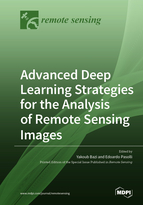Advanced Deep Learning Strategies for the Analysis of Remote Sensing Images
A special issue of Remote Sensing (ISSN 2072-4292). This special issue belongs to the section "Remote Sensing Image Processing".
Deadline for manuscript submissions: closed (30 November 2020) | Viewed by 105045
Special Issue Editors
Interests: remote sensing image processing and analysis
Special Issues, Collections and Topics in MDPI journals
Interests: multi/hyperspectral remote sensing; image processing and analysis; machine learning; pattern recognition; computer vision
Special Issues, Collections and Topics in MDPI journals
Special Issue Information
Dear Colleagues,
The last two decades have unveiled that remote sensing (RS) has become an essential technology in monitoring urban, atmospheric, and ecological changes. The increased availability of satellites and airborne sensors with different spatial and spectral resolutions has made this technology a key component in decision making. In addition to these traditional platforms, a new era has been opened recently by the adoption of UAVs for diverse applications such as policing, precision farming, and urban planning.
The great potential provided in terms of observation capability introduces similarly great challenges in terms of information extraction. Yet, processing the massive data collected by these diverse platforms is impractical and ineffective using traditional image analysis methodologies. This calls for the adoption of powerful techniques that can extract reliable and impressive information. In this context, deep learning (DL) strategies have recently been shown to hold the great promise of addressing the challenging needs of the RS community. Indeed, the introduction of DL dates back decades ago, when the first steps towards building artificial neural networks were undertaken. However, due to the limited processing resources, it did not reach a cutting-edge success in data representation and classification tasks until the recent appearance of high-performance computing facilities. This in turn enabled the design of sophisticated deep neural architectures and boosted the precision of many problems to groundbreaking performances.
This Special Issue welcomes papers that explore novel and challenging topics for the analysis of remote sensing images acquired with diverse platforms. Welcome topics include but are not limited to the following:
- Semantic segmentation;
- Domain adaptation from single and multiple sources;
- Continual learning;
- Exploration of the relationship between natural language and remote sensing images (bidirectional text to image retrieval, image captioning, visual question answering);
- Crowd estimation in UAV imagery;
- Image generation and conversion using generative adversarial networks.
Dr. Yakoub Bazi
Dr. Edoardo Pasolli
Guest Editors
Manuscript Submission Information
Manuscripts should be submitted online at www.mdpi.com by registering and logging in to this website. Once you are registered, click here to go to the submission form. Manuscripts can be submitted until the deadline. All submissions that pass pre-check are peer-reviewed. Accepted papers will be published continuously in the journal (as soon as accepted) and will be listed together on the special issue website. Research articles, review articles as well as short communications are invited. For planned papers, a title and short abstract (about 100 words) can be sent to the Editorial Office for announcement on this website.
Submitted manuscripts should not have been published previously, nor be under consideration for publication elsewhere (except conference proceedings papers). All manuscripts are thoroughly refereed through a single-blind peer-review process. A guide for authors and other relevant information for submission of manuscripts is available on the Instructions for Authors page. Remote Sensing is an international peer-reviewed open access semimonthly journal published by MDPI.
Please visit the Instructions for Authors page before submitting a manuscript. The Article Processing Charge (APC) for publication in this open access journal is 2700 CHF (Swiss Francs). Submitted papers should be well formatted and use good English. Authors may use MDPI's English editing service prior to publication or during author revisions.
Keywords
- Multispectral/hyperspectral/UAV imagery
- Natural language and remote sensing
- Classification, restoration, super-resolution, retrieval, change detection
- Convolutional neural networks (CNNs)
- Generative adversarial networks (GANs)







